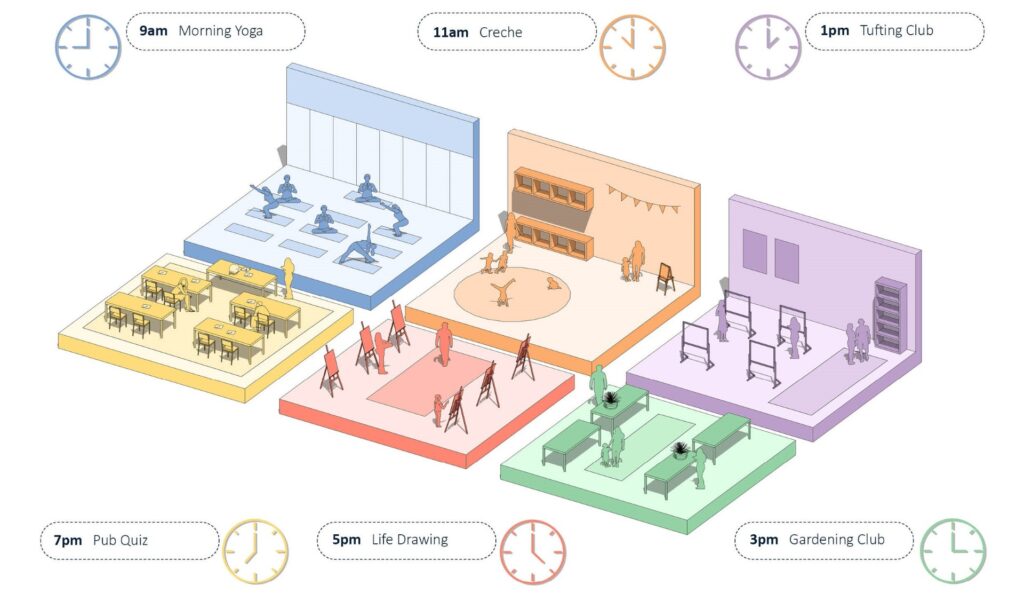Over the past 10 years Built to Rent has shifted from a relatively unknown, often misunderstood concept to an integral asset class with a growing understanding of the vital role it can play in housing delivery in the UK. As the sector faces continued challenges in viability combined with an increasingly difficult regulatory landscape what can we learn from the sectors evolution to date and how will it continue to evolve in the future?
The end of the Amenity Space Race?
From its outset a key differentiator for the sector has been the provision of high quality, shared amenity space. With the age-old question being how much amenity should we provide? In the absence of a ‘magic number’ this led to an increasing drive the accommodate as much amenity as practically possible. These spaces often manifested in response to the latest trends through specific uses with their own specific spatial requirements. As trends shift and people’s requirements change this has led to underutilised spaces that are difficult to adapt to meet changing needs.
This has seen a shift to a more practical approach to amenity provision where flexibility and adaptability is key. Well designed, flexible spaces can work much harder spatially whilst being adaptable to the changing needs of residents. This is coupled with a shift from the faddy to the practical through spaces that prioritise the functional and convenient. From an increased demand for shared workspace to places for people to host guests away from their apartments without the need for the mandatory tidy up or hassle of the post dinner clean up.

Community not amenity
If amenity space in the attractor, community is almost certainly the retainer of residents. A clear USP of Build to Rent is the ability to foster social connection, belonging and engagement with fellow residents. Whilst the spaces we create have an impact in how they facilitate this its success often comes down to the ongoing curation and management of the living experience. In this context we are also seeing a clear shift from relatively inward-looking Build to Rent developments to schemes that embrace wider context and its community. This can extend to providing amenity spaces that can be used by both the buildings residents and wider community to maximise social interaction and even provide additional revenue.
Evolution to building typologies has also seen a move away from doughnut blocks and sticks on plinths to multi building Build to Rent propositions that place an emphasis on the places and spaces that can be inhabited between buildings. Combining this with a range of different uses starts to provide 24-hour activation and more opportunities for social interaction within thriving mixed use communities people will want to call home.

Social sustainability through mixed tenure development
Is there an opportunity to build on the benefits of providing a range of uses by integrating different living typologies in a more meaningful way? In a world where Build to Rent developments are often inhabited by a range of different demographics could this be expanded further? Is there a model that looks to combine different rental typologies into one place to provide additional social sustainability through the integration of people of different demographics and generations. This could combine Build to Rent, Co-Living, Student Accommodation and Later Living into one holistic proposition. Whilst this could manifest in many different ways however the shared requirements across tenures could lead to greater efficiency in operation, potential for greater flexibility in delivery and security when bringing product to market.
Broadening the typological horizon
Typically, Multi Family Build to Rent developments consist of a range of one, two and three-bedroom homes often targeted towards a younger demographic. In practice we are seeing multiple examples where there is much more variation in the demographic of residents being drawn to the Build to Rent experience. With increased numbers of families or older residents with more disposable income there are examples where the smaller proportion of larger homes are the ones that are in increased demand. But rather than simply increase the number of three beds can we go further in how we expand the range of typologies that a Build to Rent community can offer? This could include townhouses, maisonettes, garden flats or larger penthouse units. The introduction of different types of homes presents the opportunity to provide variety for a range of residents whilst offering a point of difference within an increasingly saturated market of homes where the product is extremely similar.
Making an Apartment a Home
Would an increased ability for residents to personalise their homes and their living experience lead to more people staying and growing within a Built to Rent development? The notion of being able to move through a development as needs change has been around for some time. A single person in a studio moving to a one bed with their partner before moving to a larger home when they start to have a family. But could the ability for a resident’s environment to change with their personal needs and lifestyle occur on a more granular level? Could a shift away from a one size fits all approach to rental living provide greater ability for residents to personalise their space on a more regular basis and allow it to feel like their own home? This could include selecting furniture packs, different interior themes or even modular layouts and adaptable furniture that could be reconfigured over time.